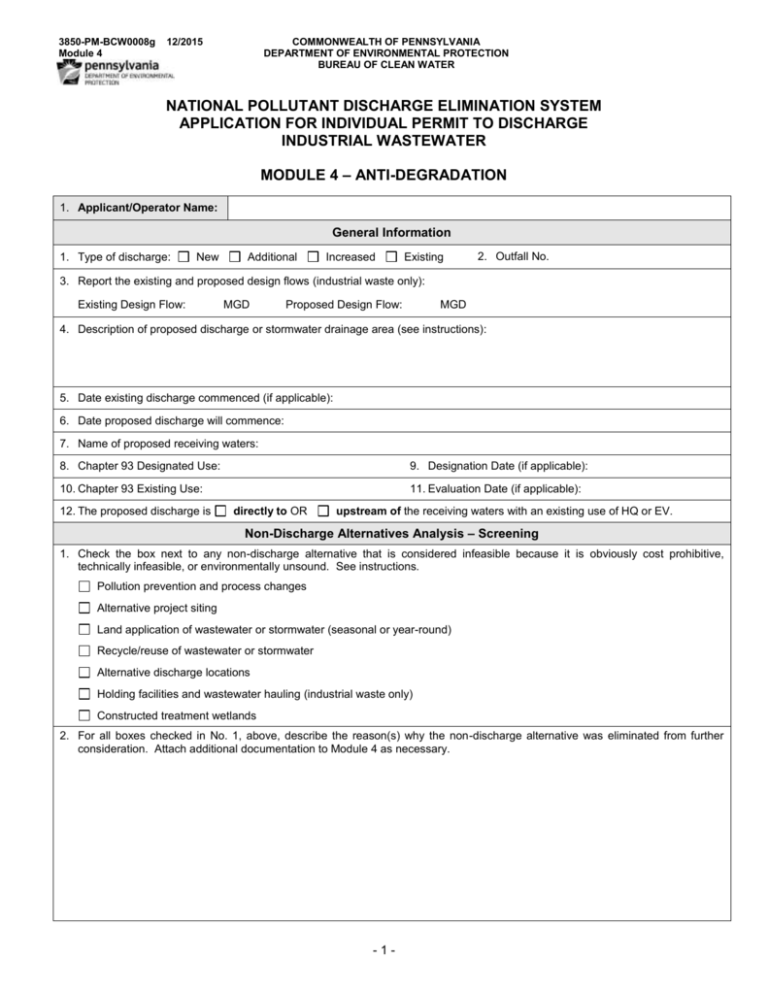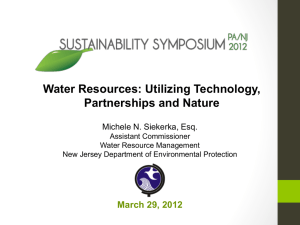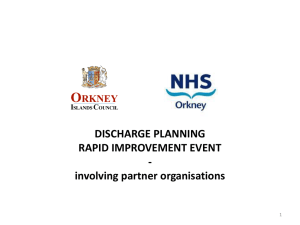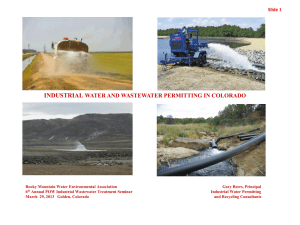Pgs1-5.rtf - DEP`s Online Library
advertisement

3850-PM-BCW0008g Module 4 12/2015 COMMONWEALTH OF PENNSYLVANIA DEPARTMENT OF ENVIRONMENTAL PROTECTION BUREAU OF CLEAN WATER NATIONAL POLLUTANT DISCHARGE ELIMINATION SYSTEM APPLICATION FOR INDIVIDUAL PERMIT TO DISCHARGE INDUSTRIAL WASTEWATER MODULE 4 – ANTI-DEGRADATION 1. Applicant/Operator Name: General Information 1. Type of discharge: New Additional Increased Existing 2. Outfall No. 3. Report the existing and proposed design flows (industrial waste only): Existing Design Flow: MGD Proposed Design Flow: MGD 4. Description of proposed discharge or stormwater drainage area (see instructions): 5. Date existing discharge commenced (if applicable): 6. Date proposed discharge will commence: 7. Name of proposed receiving waters: 8. Chapter 93 Designated Use: 9. Designation Date (if applicable): 10. Chapter 93 Existing Use: 11. Evaluation Date (if applicable): 12. The proposed discharge is directly to OR upstream of the receiving waters with an existing use of HQ or EV. Non-Discharge Alternatives Analysis – Screening 1. Check the box next to any non-discharge alternative that is considered infeasible because it is obviously cost prohibitive, technically infeasible, or environmentally unsound. See instructions. Pollution prevention and process changes Alternative project siting Land application of wastewater or stormwater (seasonal or year-round) Recycle/reuse of wastewater or stormwater Alternative discharge locations Holding facilities and wastewater hauling (industrial waste only) Constructed treatment wetlands 2. For all boxes checked in No. 1, above, describe the reason(s) why the non-discharge alternative was eliminated from further consideration. Attach additional documentation to Module 4 as necessary. -1- 3850-PM-BCW0008g Module 4 12/2015 Non-Discharge Alternatives Analysis – Detailed Complete this section for each non-discharge alternative that was not eliminated through the Non-Discharge Alternatives Analysis Screening. Include any additional alternatives not listed in the Screening section. A minimum of three alternatives is required. 1. Name/Description of Non-Discharge Alternative: 2. Explain why this alternative may be feasible in lieu of a discharge (i.e., describe the “pros” of this alternative). 3. Describe the challenges (“cons”) associated with this alternative. 4. Explain how the environmental factors identified in the instructions to Module 4 were considered. 5. Direct comparison of present worth or equivalent annual costs (attach a narrative with calculations to Module 4): Discharge Alternative: $ Non-Discharge Alternative: $ 6. Is this non-discharge alternative cost effective and environmentally sound? Yes No Explain your answer and describe any efforts that will be made to partially implement this alternative, if applicable. -2- 3850-PM-BCW0008g Module 4 12/2015 Non-Degrading Discharges – Industrial Waste 1. For new, additional or increased industrial waste discharges, the applicant must contact DEP to request preliminary effluent limitations (PELs) prior to submission of the permit application. Were PELs issued by DEP to the applicant for the proposed discharge? Yes No If Yes, date PELs issued: (attach copy of DEP’s letter containing PELs to Module 4). If No, DEP may deny or return the permit application. 2. Does the applicant intend to install and operate the technology necessary to achieve the PELs? Yes No If Yes, complete question 3, below. If No, check the following box to indicate that an SEJ is attached (HQ waters only): 3. Describe the technology(ies) that will be utilized to achieve effluent limitations in an NPDES permit. Non-Degrading Discharges – Industrial Stormwater 1. Is the stormwater discharge a result of site construction activities? Yes No Describe the activities or site modifications that will result, or have resulted, in the stormwater discharge. 2. Is an NPDES permit for stormwater associated with construction activities under 25 Pa. Code Chapter 102 required prior to commencing the proposed discharge? Yes No If Yes, specify the date the permit application was submitted: Not Submitted If No, indicate the earth disturbance associated with the proposed discharge: acres 3. Is the stormwater rate or volume from the site expected to increase following the new activities or site modifications? Yes No N/A Provide an explanation for the answer below. 4. Will the applicant create and maintain a condition of “No Exposure” within the stormwater drainage area? Yes No If Yes, the applicant certifies that it will notify DEP prior to making changes that could modify the No Exposure condition. Yes No If No, identify possible pollutants and estimated pollutant concentrations in the discharge as an attachment to Module 4. -3- 3850-PM-BCW0008g Module 4 12/2015 5. Anti-Degradation Best Available Combination of Technologies (ABACT) If the net change in stormwater discharges is not fully eliminated by non-discharge alternatives, the applicant must utilize ABACT BMPs to manage the change. Select the technologies that will be, or have been, used to ensure that the discharge will be a non-degrading discharge. Treatment BMPs: Pollution Prevention: Land Disposal: Infiltration Practices Disconnection of roof drainage Vegetated Filters Wet Ponds Bio-Retention / Bio-Infiltration Riparian Buffers < 150 ft Wetland Treatment Systems Street Sweeping Riparian Forest Buffers < 150 ft Vegetated Swales PPC Plans Manufactured Devices Non-structural Practices Cisterns Bio-Retention / Infiltration Land Preservation Rain Barrels Green Roofs Restoration BMPs Spray/Drip Irrigation Other: Nutrient, pesticide, herbicide or other chemical application plan alternatives Dry Hydrant w/Underground Storage Stormwater Reuse Technologies: -4- 3850-PM-BCW0008g 12/2015 Module 4 Instructions COMMONWEALTH OF PENNSYLVANIA DEPARTMENT OF ENVIRONMENTAL PROTECTION BUREAU OF CLEAN WATER NATIONAL POLLUTANT DISCHARGE ELIMINATION SYSTEM APPLICATION FOR INDIVIDUAL PERMIT TO DISCHARGE INDUSTRIAL WASTEWATER INSTRUCTIONS FOR MODULE 4 – ANTI-DEGRADATION If the applicant is proposing any new, additional or increased discharge to receiving waters with existing uses of “High Quality” (HQ) or “Exceptional Value” (EV) under Chapter 93 of DEP’s regulations, Module 4 must be completed. Module 4 must also be completed for existing discharges to HQ/EV waters seeking NPDES permit coverage for the first time. Module 4 is to be used for both industrial waste (process or non-process) discharges and industrial stormwater discharges. DEP encourages applicants proposing such discharges to meet with DEP in advance of a permit application submission to ensure proper understanding of DEP’s anti-degradation requirements. The applicant should be familiar with DEP’s Water Quality Antidegradation Implementation Guidance (391-0300-002) (“Anti-Degradation Guidance”). On the top of Module 4, identify the applicant or operator name, as reported on page 1 of the industrial wastewater permit application. General Information This section must be completed for all discharges. 1. Type of proposed discharge – check the appropriate box to indicate whether the discharge is considered New, Additional, Increased or Existing. These terms are defined as follows: New Discharge: a wasteload not previously present on construction/placement and permitting of a new treatment facility. Additional Discharge: flow and/or loading added to an existing waste stream that would not require construction to accommodate the added waste flow. Increased Discharge: flow and/or loading added to an existing waste stream that would require new construction to accommodate the increased waste flow. Existing Discharge: a discharge that exists but is not permitted and the applicant is seeking permit coverage for the discharge for the first time. that water body that requires the 2. Identify the outfall number(s) for the proposed discharge(s), as reported on the industrial waste permit application (3850-PM-BCW0008b). 3. For industrial waste discharges only, list the existing and proposed design flows for the proposed discharge, in million gallons per day (MGD). Only the proposed design flow should be reported for new discharges. The purpose of this question is to establish the increase in flow being proposed for additional or increased discharges. If a design flow is not applicable, report the existing and proposed average flow associated with normal production or operation. 4. Describe the proposed discharge, including what upgrades or changes will occur on-site that will result in the discharge, and the pollutants whose concentrations are expected to increase as a result of the upgrades or changes. Attach separate pages as necessary. 5. For additional, increased and existing discharges, report the (approximate) date the existing discharge commenced. For new discharges enter “Not Applicable.” If unknown the applicant may report this, or otherwise provide a description such as “prior to 1980.” 6. Report the date that the proposed discharge will commence (or the date the applicant desires the discharge to commence). -1- 3850-PM-BCW0008g 12/2015 Module 4 Instructions 7. List the name of the proposed receiving waters. 8. Identify the designated use for the proposed receiving waters as listed in 25 Pa. Code Chapter 93 (available online at www.pacode.com, “Water Uses Protected”). For example, WWF, CWF-MF, HQ-CWF, EV, etc. 9. Complete this question only for existing discharges requiring permit coverage for the first time (i.e., not new, additional or increased discharges). For receiving waters designated for HQ or EV in Chapter 93, report the date DEP designated the receiving waters as HQ or EV. This information is important for DEP to evaluate whether the discharges may be “grandfathered,” and is only available by contacting DEP’s Division of Water Quality Standards at (717) 787-5017. 10. Identify the existing use for the proposed receiving waters. This information is not available in Chapter 93. The applicant must check DEP’s Existing Use website at the following address: www.portal.state.pa.us/portal/server.pt/community/existing_use/10557 If the proposed receiving waters are not in the existing use list, the existing use is the designated use reported for question 8, above. 11. If the proposed receiving waters are in the existing use list, report the date the evaluation for existing use was made (“Date of Eval” column in list). 12. Check the appropriate box to indicate whether the proposed discharge is directly to or upstream of the receiving waters with an existing use of HQ or EV. Note that anti-degradation requirements also apply to discharges upstream of HQ or EV waters if such discharges have the potential to affect water quality of downstream HQ or EV waters. Non-Discharge Alternatives Analysis – Screening This section must be completed for all discharges. DEP’s anti-degradation regulations require the use of non-discharge alternatives for projects and activities generating new, additional, or increased point source discharges to HQ or EV waters when such alternatives are cost-effective and environmentally sound. In accordance with DEP’s Anti-Degradation Guidance, a preliminary screening of nondischarge alternatives is to be completed to rule out alternatives that are considered infeasible because they are obviously cost prohibitive, technically infeasible or environmentally unsound. Affordability analysis guidelines are provided in Chapter 7 of the Anti-Degradation Guidance. 1. Check the box next to any non-discharge alternative that is determined to be infeasible based on the guidelines provided in Chapter 7. The following common non-discharge alternatives must be evaluated in this screening analysis (see DEP’s Anti-Degradation Guidance for descriptions of these alternatives): Pollution prevention and process changes; Alternative project siting; Land application of wastewater or stormwater (seasonal or year-round); Recycle/reuse of wastewater or stormwater; Alternative discharge locations; Holding facilities and wastewater hauling (industrial waste only); and Constructed treatment wetlands. Pollution prevention and process changes and holding facilities and wastewater hauling alternatives are intended only for industrial waste discharges. For outfalls receiving industrial stormwater discharges only, the applicant should check these boxes. 2. For all boxes checked in the previous question, describe the reason(s) why the non-discharge alternative was eliminated during the screening analysis for further consideration. Attach separate documentation if necessary. -2- 3850-PM-BCW0008g 12/2015 Module 4 Instructions Non-Discharge Alternatives Analysis – Detailed This section must be completed for all discharges. The applicant may develop and submit the information in this section in report format in lieu of completing this section (if this is done, refer to the report when responding). A minimum of three non-discharge alternatives must be considered in detail and reported in this section. The three alternatives may be from the list provided in the Non-Discharge Alternatives Analysis – Screening section or others as determined by the applicant. Complete the Non-Discharge Alternatives Analysis – Detailed section for each alternative considered in detail. 1. Name or describe the non-discharge alternative that is considered in detail. 2. Explain the “pros” of this alternative in terms of practical implementation and environmental benefits in comparison to the proposed discharge to surface waters. 3. Describe the “cons” of this alternative in terms of practical implementation, environmental considerations and other factors in comparison to the proposed discharge to surface waters. 4. Explain how the following environmental factors, at a minimum, were considered in determining the pros and cons of the alternative, as applicable: Sensitivity of stream uses; Need for low-flow augmentation of stream flow; Sensitivity of groundwater uses in the area; Potential to induce secondary water quality impacts (physical habitat alteration); and System reliability and potential for upsets/accidents. 5. Determine and report the present worth or equivalent annual costs for a non-degrading discharge and the non-discharge alternative discussed in this section. See Chapter 7 of DEP’s Anti-Degradation Guidance for recommended calculations. Attach a narrative on the approach used to determine costs as well as the calculations to Module 4. For the determination of costs associated with the discharge alternative, be sure to factor in anticipated operational, maintenance, laboratory, and residual disposal costs. The evaluation of treatment technology(ies) necessary to produce a non-degrading discharge including the costs associated with the treatment system(s) is typically conducted at this stage in conjunction with the non-discharge alternatives analysis. Evaluation of a non-degrading discharge sets the baseline for the determination of cost-effectiveness for each of the evaluated non-discharge alternatives. See the next section for information on non-degrading discharges. 6. Check the appropriate box to indicate whether the non-discharge alternative, following a detailed evaluation, is cost effective and environmentally sound. Explain your answer and describe any efforts that will be made to implement (or partially implement) the alternative. For example, if it is determined that year-round land application is not cost effective and environmentally sound, consider whether it may be effective and sound to perform land application seasonally. Non-Degrading Discharges – Industrial Waste This section applies only to industrial waste discharges. Note – this section is not necessary if one or more of the non-discharge alternatives is considered cost effective and environmentally sound (DEP’s regulations require the use of such alternatives in such cases). 1. Check the appropriate box to indicate whether preliminary effluent limitations (PELs) were issued by DEP prior to the submission of the permit application. A request by the applicant for PELs to DEP is required prior to preparation of the application to allow for consideration of the treatment costs that may be required if the discharge alternative is pursued. If a letter was issued by DEP containing PELs for the project, attach a copy of the letter to Module 4. (Note that actual effluent limitations developed for a draft NPDES permit may differ from PELs). If PELs were not issued by DEP, the application may be denied or returned by DEP. -3- 3850-PM-BCW0008g 12/2015 Module 4 Instructions 2. Check the appropriate box to indicate whether the applicant intends to install and operate the technology necessary to achieve the PELs or non-degrading discharge concentrations. If Yes, answer question 3. If No, skip question 3 and indicate whether a Social and Economic Justification (SEJ) is attached to Module 4 to justify degradation of HQ waters (an SEJ is not applicable to waters with an existing use of EV). Refer to Chapter 10 of the Anti-Degradation Guidance for more information on preparing an SEJ for the project. Note that SEJs should clearly identify and explain the social and/or economic benefits that the project will bring to the community in which the project will be located. For HQ waters, if No is selected for this question and an SEJ is not attached, DEP cannot give further consideration to authorizing the proposed discharge. For EV waters, if No is selected for this question, DEP cannot authorize the proposed discharge. 3. Describe the technology(ies) that will be utilized to achieve effluent limitations in an NPDES permit. For the purpose of this question, the applicant may assume that the PELs will be the effluent limitations in an NPDES permit. Sufficient information must be provided in order to demonstrate that the technology(ies) represent best available combination of cost effective treatment, land disposal, pollution prevention and wastewater reuse technologies (ABACT). Non-Degrading Discharges – Industrial Stormwater This section applies only to industrial stormwater discharges. This section is not necessary if one or more of the non-discharge alternatives is considered cost effective and environmentally sound. In general, DEP considers industrial stormwater discharges that are controlled by post-contruction stormwater management BMPs implemented under 25 Pa. Code Chapter 102 (in which the rate and volume of stormwater discharges following construction does not exceed pre-construction levels) and “No Exposure” conditions to be non-degrading. For existing stormwater discharges to HQ/EV waters seeking permit coverage for the first time, DEP may also consider existing stormwater quality data. 1. Check the appropriate box to indicate whether the proposed stormwater discharge will occur as a result of planned site construction activities. Describe the site activities or modifications that will produce the new, additional or increased discharge. Attach a separate report as necessary. 2. Check the appropriate box to indicate whether an NPDES permit for stormwater associated with construction activities under 25 Pa. Code Chapter 102 is required prior to commencing the proposed discharge. If Yes, indicate the date in which the NPDES Chapter 102 permit application was submitted, or check the box to indicate the application has not yet been submitted. If No, specify the acre(s) of earth disturbance associated with the site activities or modifications that will result in the stormwater discharge. 3. Check the appropriate box to indicate whether the stormwater rate or volume from the site expected to increase following new activities or site modifications resulting in a new, additional or increased stormwater discharge. Check the box for "N/A" for existing stormwater discharges seeking permit coverage for the first time. Explain the rationale for your answer in the space provided. 4. Check the appropriate box to indicate whether a condition of “No Exposure” will exist and be maintained within the stormwater drainage area of the proposed discharge. No Exposure is defined in 25 Pa. Code 92a.2 as a condition “where industrial materials and activities are protected by a storm-resistant shelter to prevent exposure to stormwater. Industrial materials and activities include, but are not limited to, material handling equipment or activities, industrial machinery, raw materials, intermediate products, by-products, final products, or waste products. Material handling activities include the storage, loading and unloading, transportation, or conveyance of any raw material, intermediate product, final product or waste product.” Note that DEP’s regulations at 25 Pa. Code 92a.32(b) do not authorize a conditional exclusion of a permit for a No Exposure condition in HQ or EV waters. Answering Yes to this question does not exclude the applicant from the permit coverage requirement but assists DEP in determining whether the new, additional or increased discharge will be non-degrading. For existing discharges, "No Exposure" will be verified by DEP through analysis of stormwater sample(s) collected by the applicant and reported in Module 1 of the industrial waste permit application. If the applicant’s response is Yes, check the appropriate box to certify that the applicant will notify DEP prior to making any changes on-site that would modify the No Exposure condition. -4- 3850-PM-BCW0008g 12/2015 Module 4 Instructions If the applicant’s response is No, for new, additional and increased stormwater discharges, identify possible pollutants and estimated pollutant concentrations in the discharge as an attachment to Module 4. For existing stormwater discharges, DEP will consider the results of stormwater sampling as reported in Module 1. 5. Select all of the ABACT stormwater BMPs that are, or will be, utilized at the site to ensure that any associated stomrwater discharges will not degrade the receiving waters. For existing discharges, DEP will evaluate the effectiveness of the existing stormwater BMPs on-site to ensure that the receiving waters are being protected from degradation. DEP will also consider stormwater sample data reported in Module 1. In general, sample results meeting benchmark concentrations (see instructions to Module 1) will be considered representative of non-degrading discharges. Sample results exceeding benchmark concentrations may be required to perform additional monitoring and reevaluate the BMPs being implemented on-site. -5-





